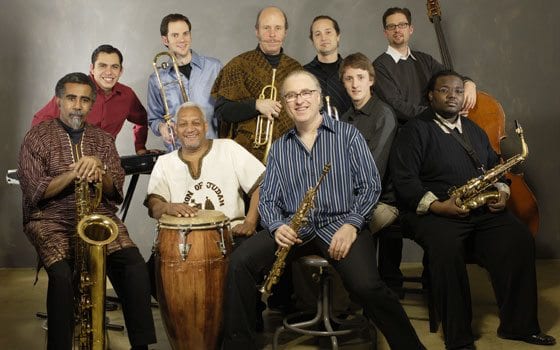
Born in Cambridge, Mass. and traveling the globe in its Afro-Latin rooted jazz odyssey, the Either/Orchestra has just returned from a concert tour in Ethiopia, the latest episode in its long-time exploration of this country’s musical traditions.
Last Thursday, at Scullers Jazz Club, the 10-member ensemble performed a captivating 90-minute set that was a sampling of its May shows in Ethiopia. The tour included concerts in tribute to Nerses Nalbandian, who from the 1930s until his death in 1977 was Ethiopia’s primary orchestral teacher, arranger and conductor. Educated in western music, Nalbandian, an Armenian, was hired by Haile Sallasie I, emperor of Ethiopia from 1930 to 1974, to create European-style marching bands in his country.
While in Addis Ababa, the Either/Orchestra performed Nalbandian’s compositions at the National Theatre (formerly the Haile Selassie I Theater), where in the ‘50s Nalbandian directed the resident orchestra.
At Scullers, the group played its own arrangements of Nalbandian’s music — infused with infectious rumba, mambo, waltz, cha-cha, tango and reggae rhythmic grooves. The evening also featured singer Teshome Mitiku, who in the late ‘60s performed with one of Ethiopia’s most popular bands, the Soul Ekos.
Rediscovery and reinvention are hallmarks of Either/Orchestra, which blends the harmonies and rhythms of RandB, African and Latin music with the verve and surprise of jazz. Combining the power of a brass-heavy ensemble with the subtle textures of members playing solo and in duos, trios and quartets within each piece, the band’s arrangements celebrate the individual gifts and collective joy of its members.
Founded in 1985 by its leader, Grammy Award winner saxophonist and composer Russ Gershon, the orchestra engages audiences here and around the world with its ebullience, virtuosity and originality.
After graduating from Harvard in 1982, Gershon, 52, stayed in Cambridge and, inspired by the innovative orchestras of Sun Ra and Gil Evans, formed the band. They played their first show at the Cambridge Public Library. Over 25 years, the band’s members have changed; but the highly sociable, danceable spirit of its music remains intact.
In 1997, the ensemble began performing original arrangements of Ethiopian songs. “We jazz people love dense, rich harmonies,” said Gershon in a phone interview. “And I found a lot of those in the Ethiopian scales.” He also savors the affinities between American and Ethiopian musicians, noting that from the 1950s onward, jazz, soul, rock have strongly influenced Ethiopian popular music. “So in a way it was like a bridge being built from both sides,” said Gershon.
In 2004, the Either/Orchestra became the first American artists to perform at the Ethiopian Music Festival and the first western big band to play in Ethiopia since Duke Ellington’s visit in 1973. The band has collaborated with such Ethiopian icons as Mulatu Astatke, the originator of “Ethio-jazz,” and Mahmoud Ahmed, the country’s most beloved singer.
The current members of the Either/Orchestra are Gershon, who plays tenor and soprano sax; Charlie Kohlhase on baritone sax; Hailey Niswanger on alto sax, clarinet and flute; trumpeters Tom Halter and Dan Rosenthal; trombonist Joel Yennior; pianist and keyboardist Josh Rosen; Rick McLaughlin on acoustic bass; drummer Pablo Bencid; and Vicente Lebron on congas and percussion.
The band began with a rumba, the traditional opening number of the Haile Selassie Theater Orchestra. A sinuous clarinet solo by Niswanger set the ensemble’s richly textured interplay of improvisation and collective power in motion.
Near the close of the set, Teshome Mitiku stepped on stage and sang two songs in the Amharic language. His mahogany tenor was a sensational complement to the band as he rendered a soulful ballad with unadorned gravitas and then deftly shifted to a song with an Afro-pop pulse.
Although Haile Selassie was unable to avert the Soviet-backed military coup that deposed him in 1974, he was in his prime a revered leader and visionary internationalist. In 1963, when he presided over the founding of the Organization of African Unity (the predecessor of the African Union), Nalbandian provided the new institution with its anthem. Lebron conjured an explosive introduction to the composition, his elbows, fingertips, palms and knuckles whirring into a blur as he beat his conga skins. After a lyrical give and take with pianist Rosen, drummer Bencid and bassist McLaughlin, the entire ensemble joined in the surging finale.




![Banner [Virtual] Art Gallery](https://baystatebanner.com/wp-content/uploads/2024/04/NJ-H_1-713x848.jpg)

